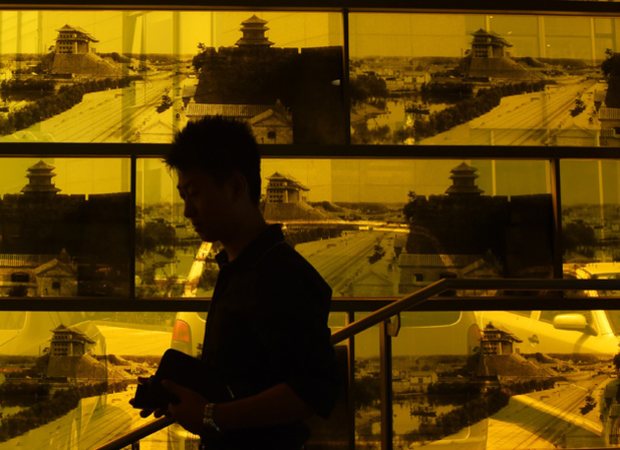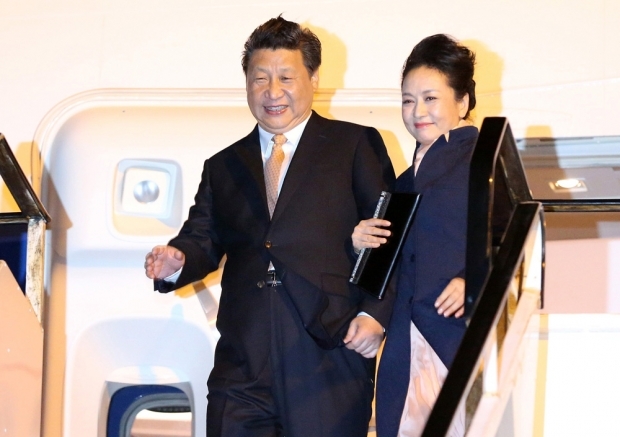The prevailing mood among China-watchers in 2014 was one of anxiety and skepticism. The year began in the shadow of Chinese assertiveness in the East and South China Seas. Economic concerns quickly took over: by February the property market seemed on the verge of an epic collapse thanks to the previous year’s sharp monetary tightening. At midyear the worry was that an endless anti-corruption campaign had caused government sclerosis, making it impossible to get anything done. And by October, as the Communist Party held its law-focused Fourth Plenum, many bemoaned both the lack of evident progress on the economic reforms outlined at the prior year’s Third Plenum and the Party’s unwillingness to let its power be constrained by Western-style rule of law. All in all, one might conclude that the main quality of Xi Jinping’s government was looking tough. Achievements were sparse.
Features
12.10.14
Why Beijing’s Troubles Could Get a Lot Worse
from Barron’sThis popular reading is unduly negative. Here is another that fits the facts at least as well: After a brief scare, the property market stabilized, in large measure thanks to the removal of unreasonable restrictions on house purchases, rather than an unsustainable blowout in credit growth. By the end of the year the economy was still growing at the fastest pace of any major economy (7.3 percent), although a slowdown next year seems likely given the apparent intention to constrain credit growth. In June the Politburo approved the biggest fiscal reform in 20 years, which aims to restructure troublesome local-government debts and revamp the tax structure to cut back on perverse incentives. November saw a significant opening of the capital account, as the “Hong Kong-Shanghai Stock Connect” program permitted investors in those two financial hubs to put money directly in each others’ stock markets. Partly in anticipation of this event, Chinese stocks staged a big rally in the second half of the year which made Shanghai the world’s second best performing market in 2014. And in December the People’s Bank of China released draft rules for deposit insurance, setting limits on the government’s unlimited guarantee of the financial system and setting the stage for full deposit-rate liberalization in the next year or two.
Politically, the anti-corruption campaign did not stop with the public fingering of former security boss Zhou Yongkang but instead shifted its focus to the People’s Liberation Army, which has a well-earned reputation as a noisome sewer of graft. While it remains hard for Xi to shake the impression that he is pursuing a vendetta against political enemies, each month that the campaign continues, and each new institution that falls prey, strengthen the argument that the anti-corruption drive is a broader effort to remake the nation’s governance structure. Another big political challenge came with the pro-democracy protests in Hong Kong following the publication of rules by the National People’s Congress permitting universal suffrage in the city’s 2017 chief executive election, but with restrictive nomination rules ensuring the victor will be compliant with the Party. Despite fears of a PLA crackdown, Beijing chose restraint and let the local government handle the matter; the protests gradually faded with little impact on either business or China’s international reputation.
Last, the external front saw a string of diplomatic successes. Tensions with Japan and Southeast Asian neighbors which rose dangerously high in 2013 were dialed down and disappeared from the headlines. A landmark gas pipeline deal was concluded with Russia, on apparently excellent terms for China, ending a decade of dithering. Three large new multilateral financial institutions sprang up under Chinese leadership, with a combined capitalization of U.S.$240 billion: the New Development Bank (originally the BRICS development bank), the Silk Road infrastructure fund, and the Asia Infrastructure Investment Bank (AIIB). And in November Beijing hosted an impressive Asia-Pacific Economic Cooperation forum meeting, which together with an almost simultaneous summit between Xi and President Obama resulted in a breakthrough on the Information Technology Agreement (an international high-tech free trade deal previously stymied by Chinese intransigence), a politically pivotal U.S.-China pact to cooperate on climate change, and two U.S.-China military agreements designed to reduce the risk of an accident in the East or South China Seas leading to armed conflict.
Name One Leader With a Better Record
This record is stronger than that of any other major world leader in the last two years. Even if one conservatively reckons the true growth rate at 6.5 percent or so, China’s economy is expanding at three times the rate of the healthiest developed economy, the U.S., and faster than the other big high-growth countries in Asia, India, and Indonesia. China has done far better with both cyclical and structural economic management than its rival Japan. Shinzo Abe has talked a brave game about his “three arrows,” but has delivered only one: aggressive monetary easing. Structural reform is absent and fiscal policy was disastrously captured by Ministry of Finance hawks, whose consumption-tax increase drove the country into a needless recession. Xi and his premier Li Keqiang by contrast have done a neat job of running monetary and fiscal policies that are expansive enough to promote growth, but disciplined enough (so far) to limit the excesses that nearly took the economy off the rails in the previous administration.
Diplomatically, Xi stacks up well. Early this year, pundits made much of Vladimir Putin’s geopolitical brilliance as he destabilized Ukraine and seized Crimea. This so-called brilliance was nothing more than the success of a bully who wins a bar fight because he is sober and wields a knife while his opponents are drunk and unarmed. Within weeks of this supposed triumph he was scurrying to Beijing to offer up natural gas on the cheap. Xi meanwhile has crystallized a strategy of patiently building up influence throughout Asia by big investments in infrastructure that will boost trade and economic growth. His task is a hard one: to increase China’s geopolitical reach while allaying fears that China seeks to subjugate its neighbors or disrupt the American-led international order. His solution, as illustrated by the flurry of announcements around the carefully orchestrated APEC summit, is a two-track policy that positions the nation both as a cooperative player in the existing order (ITA, climate change) and as the leader of an emergent one (AIIB, New Development Bank).
Writing the Authoritarian Playbook
Such a scorecard would earn most leaders accolades; why then does so much commentary suggest that economic reform is at a standstill, the anti-corruption campaign is nothing more than a series of gangland rubouts, that China’s diplomacy is bellicose and disruptive—in other words, that Xi is not much more than a Putin with Chinese characteristics? There are two broad reasons.
First, Xi is playing a long game, and long games are hard to read. Because so much of the foreign interest in China is economic, Western analysts habitually construe reforms in narrow economic terms; but Xi’s ambitions are far loftier and involve remaking the entire Chinese system of governance. Accepting this premise makes it easier to understand the anti-corruption campaign as a crucial first step in the reshaping of political institutions, rather than as a crude power-grab. An authoritarian reformer, Xi draws on precedents from regional history. Anti-corruption drives were central early-stage tactics for Park Chung-hee (who brutally converted South Korea from crony-capitalist basket case to developmental success story in the 1960s and ’70s) and Chiang Ching-kuo (who in the 1980s reined in the epic corruption of his Guomindang party and set Taiwan on a course for democracy and high-technology prowess). This stance also explains the primacy of fiscal reforms—essential for adjusting the balance of power between central and local governments—over the financial reforms that mesmerize the foreign business press.
As a nationalist, Xi wants a reform program whose economic beneficiaries will mainly be domestic firms. This makes him not a crony capitalist, but an ordinary political leader. Outside analysts accustomed to measuring China’s economic progress by how many benefits it grants to foreign companies, though, are naturally disappointed. Finally, most of the reforms outlined at the Third Plenum had an explicit or implicit target date for completion of 2020. (Fiscal reform, timed for completion in 2016, is a notable exception.) Given this time scale—an appropriate one for far-reaching structural adjustment—it is a bit premature to fret when none of the goals has been met in the first year. The direction is clear and concrete steps have been taken in almost every major reform area, which is quite a bit more than could be said about the aimless second term of the previous government.
At Bottom, We Just Don’t Like Commies
The other, profounder reason for enduring skepticism is the conviction among outsiders that the Chinese Communist Party runs an illegitimate regime. The assumption of illegitimacy leads to a presumption of fragility. Because China’s leaders have no electoral mandate, the story goes, they must keep economic growth running at some arbitrarily high rate (eight percent? seven percent? six percent?), or the regime will collapse. Failure to contain environmental damage will lead to protests that will cause the regime to collapse; fixing environmental damage may slow the economy to such a degree that the regime will collapse. Failure to adopt Western-style rule of law will lead to social discontent that will cause the regime to collapse. No problem can simply be a problem; it must be an existential crisis.
Here’s the truth: the Chinese state is not fragile. The regime is strong, increasingly self-confident, and without organized opposition. Its economic management is competent and pragmatic. Its responsiveness to social pressures on issues such as the environment is imperfect, but well-informed by research and public opinion surveys. It derives real legitimacy from its consistent demonstrated ability to raise living standards, provide a growing range of public goods, and maintain a high level of order while mostly letting people do what they want in their daily lives (unless what they want is to organize against the government). Like any large state, China has large problems, but the Party’s rule is not threatened by umbrella-wielding students in Hong Kong or striking schoolteachers in Heilongjiang, any more than the American regime is threatened by rioters in Ferguson.
In short, China is a successful authoritarian developmental state which is now rich enough to start setting its own rules rather than just accepting other peoples’. That is the Xi project. To recognize this fact does not require one to celebrate it, or to ignore the costs of the authoritarian strategy. So long as it insists on clamping down on information networks, China can never become a global technological leader or anything close to it. So long as it deprives citizens of political and civil rights considered basic in virtually every other middle- or upper-income country in the world, it will remain a cultural desert and its “soft power” will be stunted. These are real costs, and big ones. But they are costs the leadership has decided to bear, and it is a fantasy to think they will be punished for this decision not to emulate the liberal democratic ideal. China, to steal John Connally’s famous phrase about the dollar, is its own country, and other people’s problem. It will develop in its own way, on its own terms, and others will just have to work with it as best they can.




